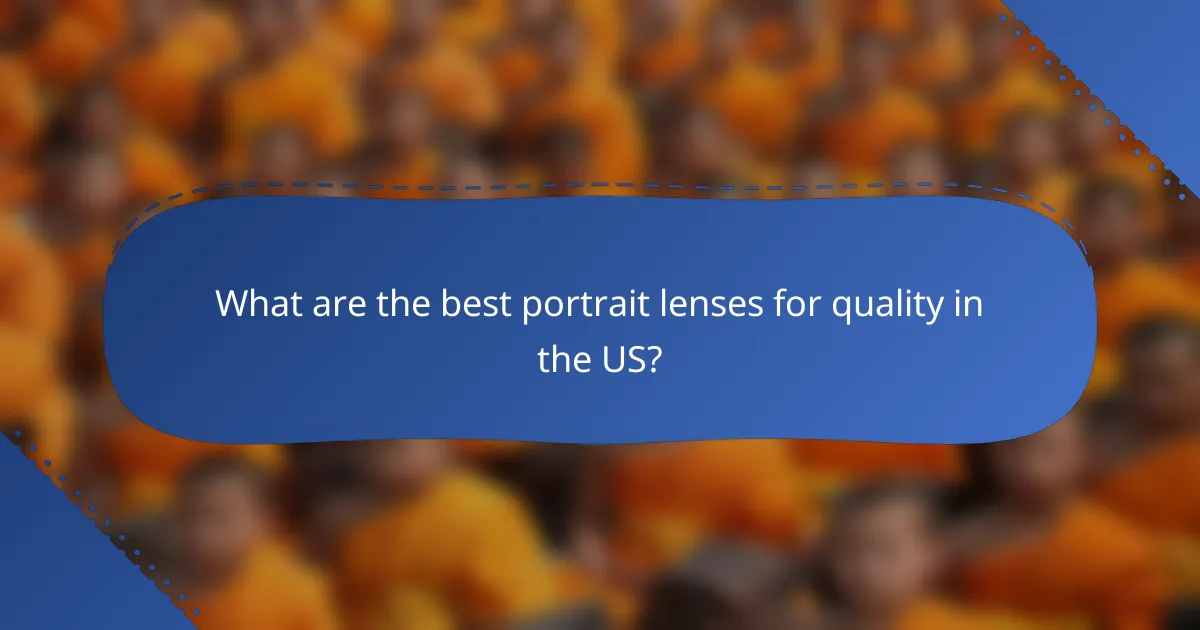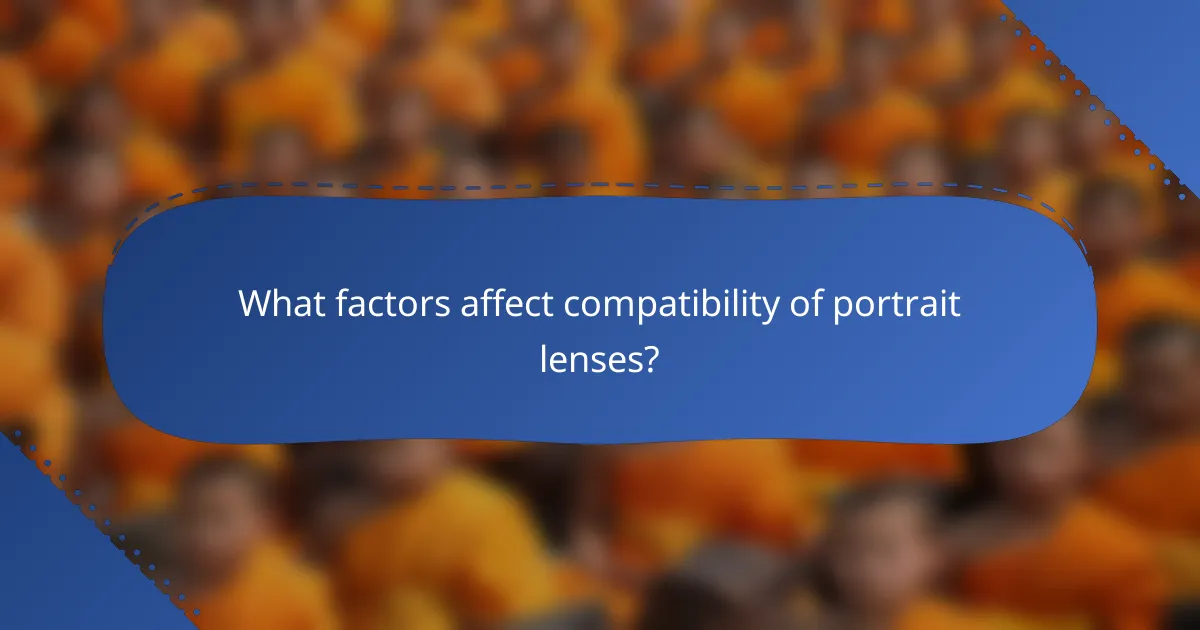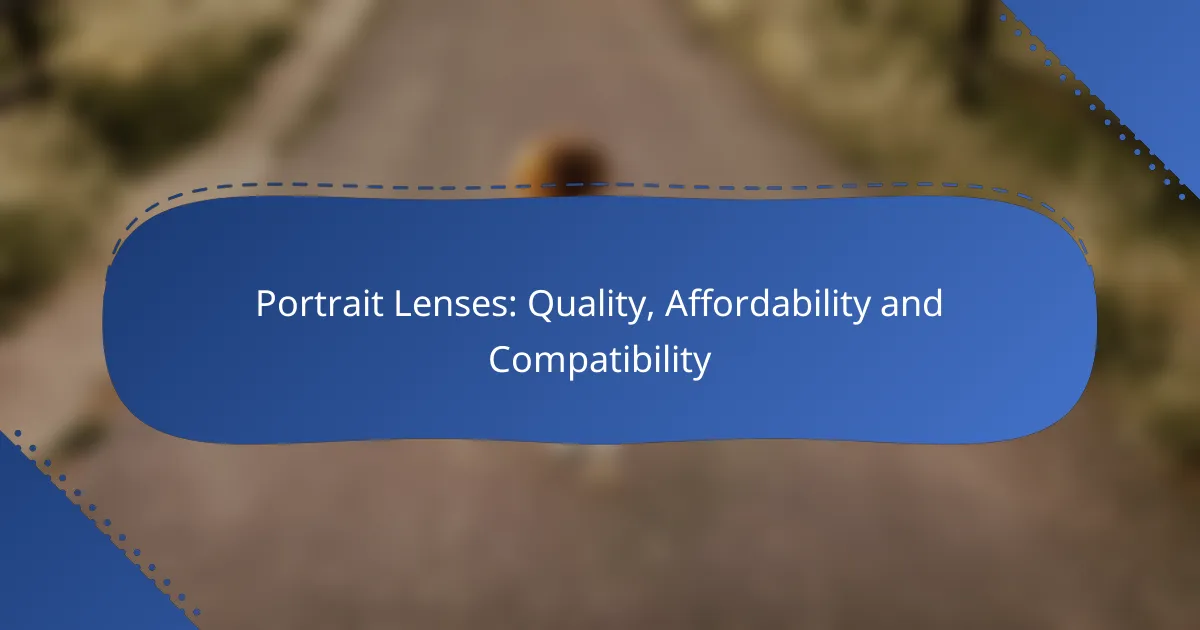When it comes to capturing stunning portraits, selecting the right lens is crucial for achieving exceptional quality, affordability, and compatibility. High-quality portrait lenses often feature wide apertures and sharpness, while also providing beautiful bokeh effects. With a range of options available to suit various budgets, it’s essential to consider compatibility with your camera system to ensure optimal performance.

What are the best portrait lenses for quality in the US?
The best portrait lenses for quality in the US typically feature wide apertures, excellent sharpness, and pleasing bokeh. Lenses like the Canon EF 85mm f/1.2L II USM, Nikon AF-S NIKKOR 85mm f/1.4G, and Sony FE 85mm f/1.4 GM are highly regarded for their performance in portrait photography.
Canon EF 85mm f/1.2L II USM
The Canon EF 85mm f/1.2L II USM is renowned for its exceptional image quality and beautiful bokeh, making it a top choice for portrait photographers. With a wide f/1.2 aperture, it excels in low-light conditions and allows for stunning subject isolation.
This lens features a robust build quality, typical of Canon’s L-series, ensuring durability in various shooting environments. However, its price point is on the higher end, so it is best suited for serious photographers who prioritize quality.
Nikon AF-S NIKKOR 85mm f/1.4G
The Nikon AF-S NIKKOR 85mm f/1.4G offers excellent sharpness and color rendition, making it a favorite among Nikon users for portrait work. Its f/1.4 aperture provides a good balance between depth of field control and low-light performance.
This lens is well-regarded for its lightweight design and fast autofocus capabilities, which can be particularly beneficial for capturing spontaneous moments. While it is more affordable than some competitors, it still represents a significant investment for hobbyists.
Sony FE 85mm f/1.4 GM
The Sony FE 85mm f/1.4 GM is a premium lens that delivers outstanding sharpness and contrast, making it ideal for portrait photography. The lens features advanced optical design, which minimizes aberrations and enhances image quality.
This lens is compatible with Sony’s full-frame mirrorless cameras and offers fast, silent autofocus, which is great for both stills and video. Although it is priced at a premium, its performance justifies the investment for professional photographers seeking high-quality results.

How do portrait lenses compare in affordability?
Portrait lenses vary significantly in affordability, catering to different budgets and needs. Generally, you can find options ranging from budget-friendly to premium, each offering distinct features and quality levels.
Budget options under $500
Budget portrait lenses typically offer decent image quality and performance for beginner photographers or those on a tight budget. Brands like Canon, Nikon, and Sigma have several models priced under $500 that can produce satisfactory results for portraits.
When selecting a budget lens, consider factors such as maximum aperture and focal length. A lens with a wide aperture (like f/1.8) can help create a pleasing background blur, enhancing portrait quality without breaking the bank.
Mid-range options between $500 and $1000
Mid-range portrait lenses provide a balance of quality and affordability, often featuring better optics and build quality than budget options. Lenses in this price range, such as the Canon EF 85mm f/1.8 or the Nikon AF-S 85mm f/1.8, are popular choices among enthusiasts and semi-professionals.
These lenses typically offer improved sharpness, better low-light performance, and more advanced features like image stabilization. Investing in a mid-range lens can significantly enhance your portrait photography experience.
Premium options over $1000
Premium portrait lenses are designed for professional photographers who demand the highest quality in their work. These lenses, such as the Canon RF 85mm f/1.2 or the Sony FE 135mm f/1.8, often come with advanced optical technologies and superior build quality.
While the price tag is higher, the investment can yield exceptional image quality, faster autofocus, and enhanced durability. For serious portrait work, a premium lens can make a substantial difference in the final results.

What factors affect compatibility of portrait lenses?
Compatibility of portrait lenses is influenced by several key factors, including the camera mount, sensor size, and autofocus functionality. Understanding these elements ensures that you select a lens that works effectively with your camera system.
Camera mount compatibility
Camera mount compatibility is crucial when choosing a portrait lens. Each camera brand typically has its own lens mount design, which means a lens designed for one brand may not fit another. For example, Canon EF lenses are not compatible with Nikon cameras without an adapter.
When purchasing a lens, check the mount type to ensure it matches your camera body. Using an adapter can sometimes work, but it may limit functionality, such as autofocus or image stabilization.
Sensor size considerations
Sensor size plays a significant role in lens compatibility, particularly in terms of field of view and depth of field. Full-frame cameras can utilize lenses designed for full-frame sensors, while crop sensor cameras require lenses that match their smaller sensor size.
For portrait photography, a lens with a longer focal length (like 85mm or 135mm) is often preferred on full-frame cameras, while a 50mm lens may suffice on crop sensor cameras. Always consider the effective focal length when selecting a lens for your specific sensor type.
Autofocus functionality
Autofocus functionality can vary significantly between different lenses and camera systems. Some lenses are designed with advanced autofocus systems that work seamlessly with specific camera bodies, while others may not support autofocus at all.
When choosing a portrait lens, verify that it offers reliable autofocus performance with your camera. Manual focus can be an alternative, but it requires practice and may not be suitable for all shooting scenarios, especially in dynamic environments.

How to choose the right portrait lens for your camera?
Choosing the right portrait lens involves considering your photography style, understanding focal lengths, and evaluating lens features. A suitable lens will enhance your ability to capture stunning portraits that reflect your artistic vision.
Assessing your photography style
Your photography style significantly influences the type of portrait lens you should select. If you prefer tight headshots, a lens with a longer focal length, such as 85mm to 135mm, can create flattering compression. For full-body shots or environmental portraits, a wider lens in the 35mm to 50mm range may be more appropriate.
Consider whether you favor natural light or studio setups, as this can affect your choice of lens speed. Lenses with larger apertures (like f/1.8 or f/1.4) are ideal for low-light situations and achieving a shallow depth of field, which is often desirable in portrait photography.
Understanding focal lengths
Focal length is crucial in portrait photography, as it determines how much of the scene is captured and how subjects are rendered. Lenses in the range of 50mm to 135mm are popular for portraits because they provide a natural perspective without distortion. A 50mm lens is versatile, while an 85mm lens is often preferred for its flattering compression.
When selecting a focal length, consider your shooting distance. Longer focal lengths require more space to achieve the same composition, which can be a limitation in smaller settings. Conversely, shorter focal lengths allow for closer shooting but may introduce distortion if too close to the subject.
Evaluating lens features
When evaluating lens features, pay attention to aperture size, image stabilization, and autofocus capabilities. A lens with a wide maximum aperture allows for better low-light performance and more control over depth of field. Image stabilization can be beneficial for handheld shooting, especially in low-light conditions.
Additionally, consider the lens mount compatibility with your camera body. Ensure that the lens you choose is compatible with your camera’s autofocus system to take full advantage of its features. Reading reviews and testing lenses in-store can help you make an informed decision.

What are the emerging trends in portrait lens technology?
Emerging trends in portrait lens technology focus on enhancing image quality, integrating smart features, and improving durability. These advancements cater to both professional photographers and enthusiasts seeking better performance and versatility in their gear.
Advancements in optical design
Recent advancements in optical design have led to the development of lenses that minimize distortion and enhance sharpness. Manufacturers are increasingly using aspherical elements and advanced glass types to achieve superior image quality, particularly in low-light conditions.
For instance, many new portrait lenses feature wider apertures, allowing for better subject isolation and bokeh effects. This is particularly beneficial for portrait photography, where the goal is often to create a pleasing separation between the subject and background.
Integration of smart technology
Smart technology is becoming a key feature in modern portrait lenses, with innovations like autofocus systems that utilize artificial intelligence. These systems can quickly and accurately track subjects, even in dynamic environments, making it easier to capture sharp images.
Additionally, some lenses now offer connectivity options that allow for firmware updates and customization through smartphone apps. This integration helps photographers adapt their equipment to specific shooting conditions or personal preferences.
Trends in lens coatings and materials
Lens coatings have evolved to improve light transmission and reduce glare, enhancing overall image quality. Multi-layer coatings are now standard, helping to prevent ghosting and flare, which is crucial for portrait photography where lighting can vary significantly.
Moreover, the use of durable materials is on the rise, with many lenses featuring weather-sealing and scratch-resistant coatings. This trend is particularly important for photographers who work in diverse environments and need reliable equipment that can withstand the elements.
